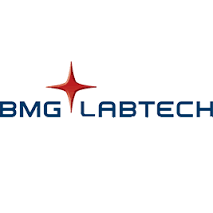Introduction
Many biological signals are transmitted by increasing or decreasing the intracellular calcium concentration (receptors, ion channels). Intracellular calcium assays are therefore used for studying a great number of biological systems. Such assays have often been done using microplate readers. Here cells are typically grown in wells and the sample/compound is added from a container using a fi xed pump/ injector or manually. To test the next sample the system has to be rinsed and the sample container replaced manually. This makes this type of assays slow and labour intensitive. This application note describes an intracellular calcium assay done using a novel microplate reader, NOVOstar with integrated pipetting system from BMG LABTECH. The NOVOstar is capable of transferring samples from one microplate to another (e.g. from a plate containing samples to a plate containing cells), greatly increasing the throughput of samples.
Materials
All materials were obtained through normal distribution channels from the manufacturer stated. Cells: CHO cells stably expressing a calcium channel. NOVOstar, BMG LABTECH, Offenburg, Germany. FLIPR® calcium assay kit, Molecular Devices Corporation, Sunnyvale, Ca. ViewplateTM -96, Black, Packard #6005182, Groningen, The Netherlands. TC-384 well plate µclear, Greiner #GR-781091, Frickenhausen, Germany. Standard medium and buffers are used. In addition, consumables such as pipette tips and tubes were used as needed from various manufacturers.
Experimental
The following is a brief description of the dye loading of cells: The day before the assay cells are seeded in 96-well plates at 16000 cells/well (100 µL) or in 384 well plates at 4000 cells/well (25 µL). Cells are grown over night in a humidifi ed incubator at 37°C and 5% CO2. At the day of the experiment the cells are removed from the incubator and loading buffer from the FLIPR® calcium assay kit is added (25 µL for 384 well plates and 100 µL for 96 well plates). The cells are then incubated for 1h at 37°C. You can also use more common calcium indicators like Fura-2, Fluo-4 and Calcium-GreenTM. A more detailed description of the cell dye loading procedure is included in the assay kit. Protocol The loaded cells are placed in the measurement position in the NOVOstar, and the sample plate is placed in the reagent plate position. The assay is done using the following parameters: Excitation fi lter is 485 nm, emission fi lter is 520 nm, injection speed 100 µL/sec, dispense depth and aspirate depth are in accordance with the volume in the well and gain is 1800. Before sample injection 3 measurements (one per second) are done to establish the baseline (kinetic window 1), then sample (4 µl for a 96-well plate, and 1 µL for a 384-well plate) is transferred from sample plate to cell plate. It takes 5.5 s for the system to transfer the sample, so the sample injection is started after 8.5 (3+5.5) seconds. At this point the sample is injected and measurements are resumed simultaneously (one per second) for 40 seconds (kinetic window 2). Immediately after sample injection mixing is performed by the system (50 µL is pipetted up and down 3 times in the well for a 96-well plate, 17 µL for a 384-well plate). Directly after mixing the pipettor needle is moved to the wash station and the needle is washed with 0.1 M NaOH followed by rinsing with system fl uid (50% ethanol). The procedure described above is then repeated for the rest of the wel
Conclusion
Using the NOVOstar we have successfully screened 96 compounds in less than 90 minutes with minimal „hands on”. This is virtually impossible to do using conventional microplate readers. If it were to be done it would take days and would require constant attention by technical staff. The screening can be done in both 96- and 384-well plates with similar results. We have also successfully used the NOVOstar for generating dose response curves. This is another assay type that can be done with great advantage in the NOVOstar due to the robotic capability of the instrument.
Text taken from www.bmglabtech.com

